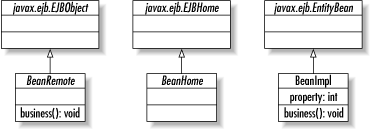| [ Team LiB ] |
|
1.2 Component ModelsWe have already touched a bit on component models. A component model defines the various aspects of encapsulating business logic in software. The Java platform provides two major component models:
Enterprise JavaBeans work well only in distributed architectures and the P2P architecture. JavaBeans, on the other hand, work in any architecture. If you use JavaBeans in a distributed architecture, however, you will have to write your own logic to support interprocess communication, security, transaction management, and other functionality that comes free with EJBs. 1.2.1 JavaBeansThe JavaBeans specification defines the way in which you should write your components so they can be used by other components and application elements. When you write JavaBeans, applications that know nothing about those beans can still use them. One example of JavaBeans in action is the development of JSP tag libraries. Your tag handlers are JavaBeans components. A JSP container can access the properties in your tag library because the way in which you write those properties uses standard getter and setter methods defined by the JavaBeans specification. The beauty of the JavaBeans specification is its simplicity. To conform to it, you need only write your getters and setters using standard getXXX( ) and setXXX( ) method calls. You can optionally implement listener support to enable applications to listen for changes in properties. There is really nothing much more to the component model. Just as simplicity is JavaBeans advantage, it is also its disadvantage. The JavaBeans specification does not provide for many of the following pieces necessary in distributed architectures:
1.2.2 Enterprise JavaBeansThe Enterprise JavaBeans component model is basically a component model for distributed architectures. It provides many of the features lacking in JavaBeans at the cost of JavaBeans simplicity. Because the EJB component model handles all of these aspects of distributed component management, you can literally pick and choose the best-designed business components from different vendors and make them work and play well with one another in the same environment. EJB is now the standard component model for capturing distributed components on the Java platform. It hides from you the details you would have had to worry about with JavaBeans. One of the benefits of the EJB approach is that it separates different application development roles into distinct parts so that the outputs of one role are usable in different environments by the players of the other roles. You can use your EJB container, for example, to house components written by third-party vendors or custom written by your team. Similarly, a JDBC service provider can deploy their JDBC drivers in any EJB container without impacting transaction management. Figure 1-11 illustrates what it takes to code a single component under the EJB component model. You have the actual bean, the home interface, and a remote interface. When you deploy a bean in a container, the container creates implementations of your home and remote interfaces. Contrast all of this work with the simplicity of the JavaBeans component model. Not only do you write just one class, but what you see is what you getónothing fancy happens out of your view. Figure 1-11. The EJB component model |
| [ Team LiB ] |
|